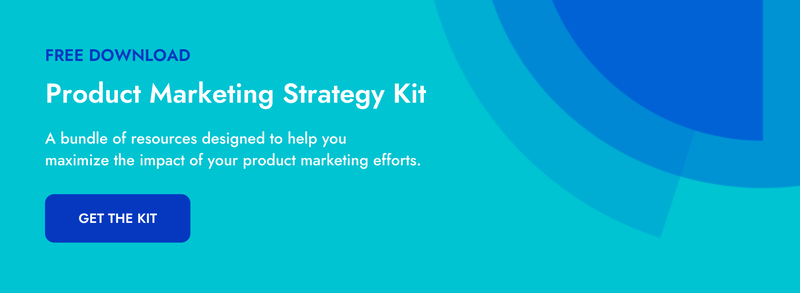If you want to win in a competitive market, you need to position and promote your solution in a way that makes prospects think, That’s exactly what I’m looking for.
Put differently, you need to do a better job of addressing your prospects’ pain points than your competitors do.
In order to do that, you need—amongst other things—a rock solid understanding of each of the four main types of pain points:
- Productivity pain points
- Financial pain points
- Process pain points
- Support pain points
In this blog post, for each of these four types, we’ll provide a definition and two examples—one B2B, one B2C. Then, we’ll share three tips for finding your prospects’ pain points.
Productivity pain points
Someone dealing with a productivity pain point is spending too much time on a task. Whether this person is aware of it or not, they can produce or accomplish just as much as they are right now in considerably less time.
B2B example from the real world
In order to succeed, B2B sales reps need to book meetings—discovery calls, product demos, pricing negotiations, and everything in between. Even in industries with relatively short sales cycles, getting prospects on the phone is a critical part of the revenue generation process.
Email, of course, is one of the primary channels through which sales reps book meetings. Due to the ubiquity of email, this approach is necessary—but it’s not without its frustrations. As anyone who’s tried to book a meeting through email knows, it can take days—and sometimes weeks—just to coordinate everyone’s availability.
To get a sense of how this pain point is addressed in the real world, take a look at Yesware’s promotion of their Meeting Scheduler feature:
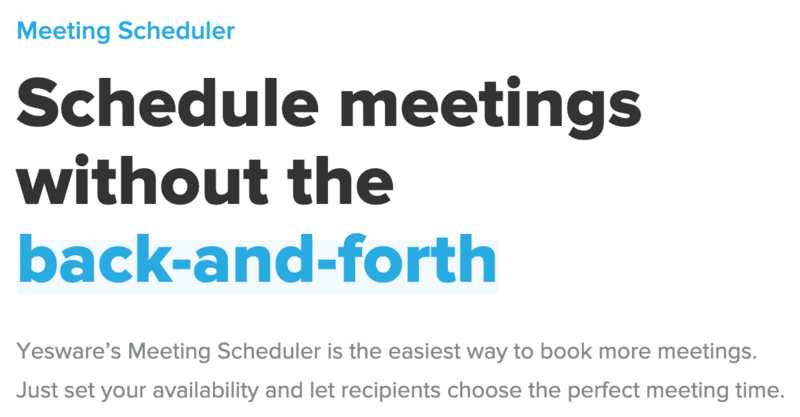
The phrase “back-and-forth” is highlighted for a reason: It’s a major source of lost productivity for B2B sales reps. Yesware could’ve gone with “Schedule more meetings” for their headline, but they went one step further—and their messaging is much more compelling as a result.
B2C example from the real world
For many, dinnertime is a crucial part of the day. It’s a time to decompress. It’s a time to connect with loved ones. It’s a time to enjoy one of life’s greatest joys: food.
Joy, however, is not the only emotion associated with dinnertime—especially when you’re cooking with and/or for several people. When other people are involved, it’s all too easy to waste precious time debating what it is you’re going to eventually eat.
To get a sense of how this pain point is addressed in the real world, take a look at HelloFresh’s promotion of their meal kit offering:
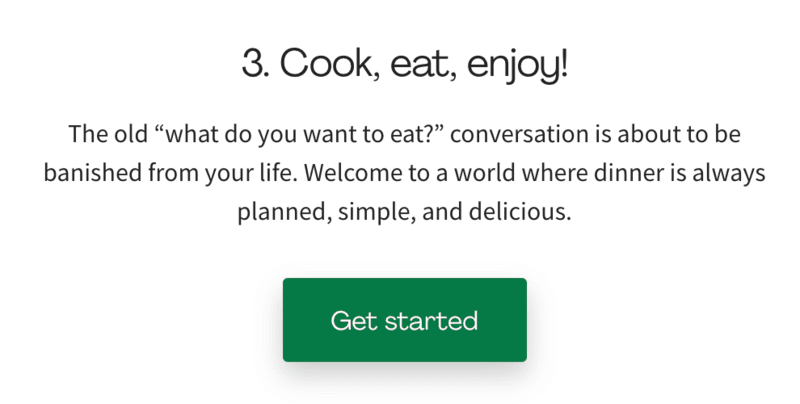
Like Yesware, HelloFresh has gone one step further with their messaging. On its own, “Welcome to a world where dinner is always planned, simple, and delicious” would make solid sub-headline copy. But the inclusion of that all-too-familiar question enables them to explicitly address a productivity pain point that frustrates a large portion of their target audience.
Financial pain points
Someone dealing with a financial pain point is spending too much money on a product, service, or tax. Whether this person is aware of it or not, they can cut down on costs without making any sacrifices.
B2B example from the real world
Freelancers represent an increasingly large segment of the global workforce—and it’s not hard to see why. As a freelancer, you can make your own hours, work from wherever you choose, and enjoy a level of creative freedom that may not be attainable in a traditional work setting.
That being said, with the glamorized benefits of freelance life come certain responsibilities that are, well, not terribly glamorous. Case in point: You need to keep track of your expenses and figure out what can and cannot be deducted from your taxable income. This is difficult, and as a result, many freelancers net less than they should.
To get a sense of how this pain point is addressed in the real world, take a look at Intuit’s promotion of their QuickBooks product:
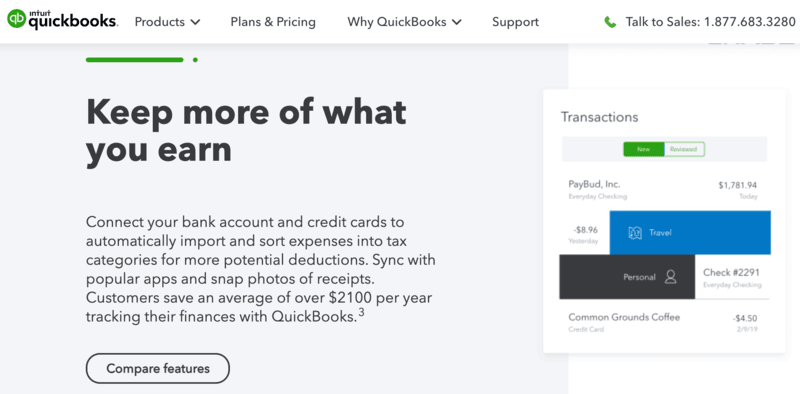
The brilliance of this headline lies in what it suggests: You’re probably giving the government more money than you need to. Even if you’re cool with living on a modest income, that’s a harrowing realization. Notably, this is a prime example of a company using their marketing copy to make prospects aware of a pain point that was previously off their radars.
B2C example from the real world
In 2015, researchers at Pew found that 76% of Americans watched TV via cable or satellite. Less than a decade later, that figure has plunged to 56%—a 26% drop. Unsurprisingly, many so-called “cord cutters” say they’ve parted ways with traditional means of watching TV because they can access the content they want via platforms like Netflix and Hulu.
But there’s another major force behind this trend: Cable and satellite services cost a lot of money. According to those same Pew researchers, 69% of cord cutters cite price as a motivator.
To get a sense of how this pain point is addressed in the real world, take a look at YouTube’s promotion of their live TV streaming service:
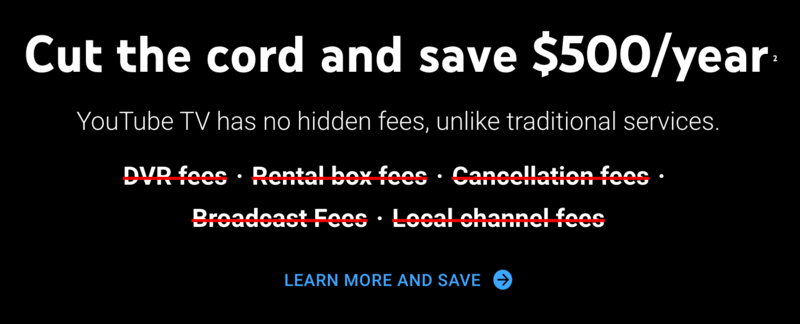
Like Intuit, YouTube references a specific dollar amount in their messaging. This is an excellent tactic for companies that relieve financial pain points, as it invites the prospect to imagine what they could do with their savings. Would $500 cover your gas bill for the rest of the year? Make a dent in your car payments? Pay for a weekend getaway? Plus, YouTube gets extra credit for backing up that $500 figure by explicitly mentioning five (infuriating) fees that typically accompany a cable subscription.
Process pain points
Someone dealing with a process pain point is trying to accomplish something in an outdated or inefficient way. Whether this person is aware of it or not, they can upgrade to a smarter way of getting things done. As you can imagine, the line between process pain points and productivity pain points is not always clear.
B2B example from the real world
Please pardon my use of cliche language: Electronic signatures have changed the way we do business. No matter where your stakeholders (internal and external) are located around the world, you can get your documents squared away in a fraction of the time that it used to take.
Nevertheless, the e-signature process is still flawed. Have you ever found yourself juggling multiple versions of a very important document as you piece together all the necessary signatures? This is not only frustrating—it’s risky, too.
To get a sense of how this pain point is addressed in the real world, take a look at Dropbox’s promotion of their HelloSign solution:
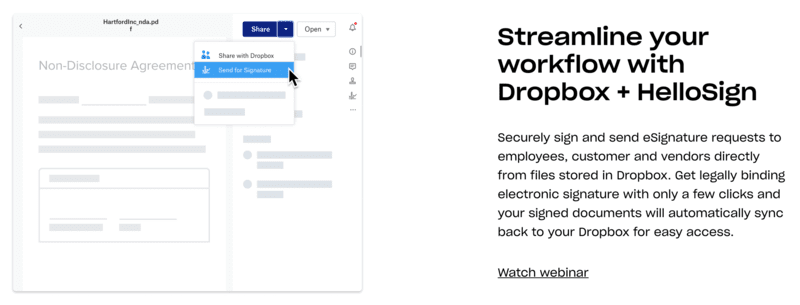
Believe it or not, I think this is an effective headline. Although “streamline” and “workflow” are ubiquitous in the software world, they’re sensible choices when you’re speaking to a process pain point. In this case, however, the best copy is underneath the headline. By promising prospects the ability to sync signed documents back to a single source of truth, Dropbox paints a picture of a better way to get things done.
B2C example from the real world
Regrettably, I need to be cliche once more: Smartphones have changed the way we manage our personal finances. Without moving from my couch, I can transfer funds from savings to checking, send rent to my landlord, and buy shares in any public company of my choosing.
But there’s a catch: In order to do those three things, I need to toggle between three different apps. Back-breaking? Of course not. Inefficient? Without a doubt—especially if, for whatever reason, my banking information were to change.
To get a sense of how this pain point is addressed in the real world, take a look at Cash App’s promotion of—well—their app:
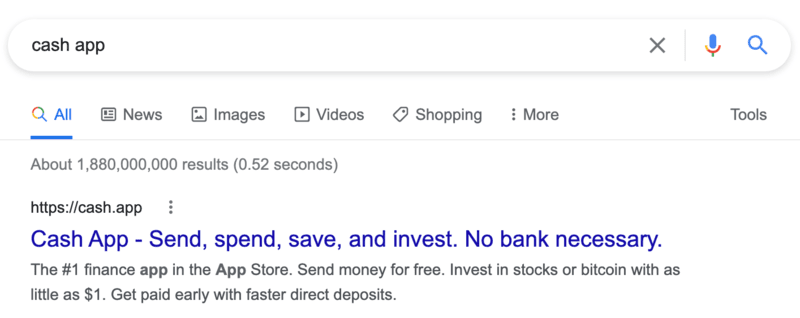
“Send, spend, save, and invest.” With five words, Cash App communicates an irresistible value proposition: Whatever you need to do with your money, you can do it here—no more jumping from one app to another. Simplicity is placed front-and-center, because that’s precisely what’s missing when you’re dealing with a process pain point.
Support pain points
Someone dealing with a support pain point is struggling to find help at a critical stage in their customer journey. Of the four types we’re discussing here today, this is probably the least likely to go unnoticed; when a lack of support is the problem, it can be extraordinarily difficult—even impossible—to do what you’re trying to do.
B2B example from the real world
Marketing automation tools give small businesses the power to check a lot of boxes that would otherwise require a full-blown team of specialists. You can build a website. You can design professional-grade emails. You can run ad campaigns.
There’s just one thing: You need to know how to use whatever marketing automation tool you’ve purchased. That’s a skill in and of itself, and just like any other skill, it requires some form of instruction. Without that instruction—without that post-purchase support—you’d be unable to check those boxes listed above.
To get a sense of how this pain point is addressed in the real world, take a look at Mailchimp’s promotion of their resource library:

This is exemplary headline copy for one key reason: It emphasizes action. In a B2B context, the distressing part of a support pain point is not the inability to do something productively; it’s the inability to do something at all. By encouraging visitors to their resource library to “do more,” Mailchimp reminds customers that their software solutions are built to enable success.
B2C example from the real world
The first time you lay down on a new mattress, it feels like a victory. You survived the never-ending stream of reviews and comparisons. You thoughtfully weighed the pros and cons of each option. You got it up the stairs and into your bedroom. You did it, right?
Not quite. At this point in its evolution, the human body still needs time to determine whether or not a new mattress is the right fit. And if you’ve ever found yourself laying on a mattress three weeks after you bought it, begrudgingly admitting that you made the wrong choice, you know how painful the lack of support can be. What on Earth am I supposed to do now?
To get a sense of how this pain point is addressed in the real world, take a look at Casper’s promotion of their free trial offer:
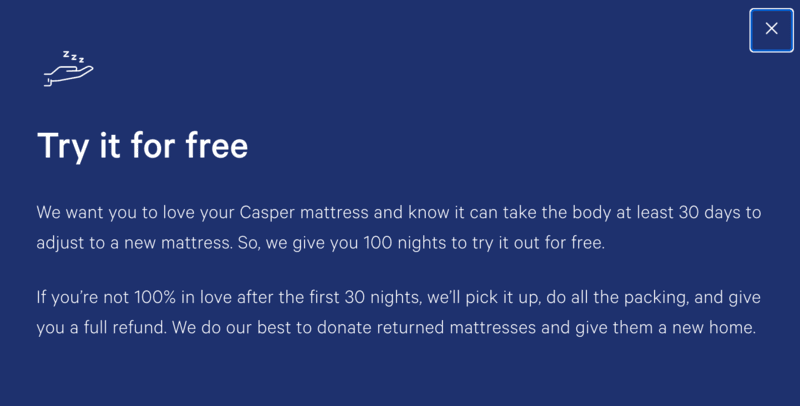
Admittedly, nothing about this copy is all that flashy; in fact, I think that’s precisely why it works. Someone dealing with (or anticipating) a support pain point isn’t looking for fireworks—they’re looking for reassurance. With this matter-of-fact messaging, Casper reassures their customers that they’ll be taken care of for a full month after purchase—which, in the case of the mattress industry, is arguably the most critical stage of the customer journey.
3 tips for finding your prospects’ pain points
Now that you have a better understanding of what, exactly, you’re looking for, here are three tips for finding your prospects’ pain points.
1. Survey your current customers
One of the best ways to find your prospects’ pain points is to survey your current customers with a short series of open-ended questions and prompts.
Open-ended is an important qualifier here. You may not realize it, but you’ve probably formed some preconceived notions as to why people buy your product—preconceived notions that may or may not be accurate. By asking open-ended questions—as opposed to yes/no questions, such as “Was XYZ a pain point before you bought our product?”—you reduce the risk of watering down and/or delegitimizing your survey results.
Imagine how much you could learn about your prospects simply by asking your customers to respond to questions and prompts like these:
- Why did you buy our product?
- Describe what life (or work) was like before you started using our product.
- How did you do XYZ before using our product?
Responses will vary across your customer base, but if you can get enough folks to participate, you’ll be able to draw actionable conclusions about your prospects’ pain points.
2. Connect with your product team
Could you build an effective product without an in-depth understanding of the problems you’re trying to solve?
Of course not—and that’s why your product team is such a wealth of knowledge when it comes to finding your prospects’ pain points. These folks wouldn’t be at your company if they didn’t have a clear vision of the problems your target customers are dealing with.
As a bonus, connecting with your product team should be much easier than surveying your customers. If these colleagues of yours are meeting with each other on a regular basis, ask if you can be a fly on the wall during a handful of their sessions. You’d be surprised how much you can learn about your prospects’ pain points simply by observing your product team in action.
3. Read online reviews of your product
The primary issue with surveying your customers is that it’s difficult to get a high volume of people to respond. Fortunately, reviews of your product posted to third-party websites offer a tremendous amount of insight into your prospects’ pain points.
Check out this excerpt from a review of ZoomInfo, a B2B sales tool:

From just a handful of sentences, here’s what I’ve learned about ZoomInfo’s prospects:
- They spend too much time researching prospects
- They struggle to get in touch with decision-makers
This doesn’t cover the full range of pain points that frustrate ZoomInfo’s prospects, but it’s a fantastic starting point. Right now, there are reviews of your product just waiting to be analyzed to your advantage. What are you waiting for?
Address your prospects’ pain points better than anyone else
Want to address your prospects’ pain points better than anyone else? Tired of manually analyzing your competitors’ marketing strategies? Eager to take action as soon as a relevant piece of intel comes to your attention?
Request a demo of Crayon. Our award-winning competitive intelligence software platform enables mid-market and enterprise businesses to cut through the noise and compete like they mean it.

Related Blog Posts
Popular Posts
-
 The 8 Free Market Research Tools and Resources You Need to Know
The 8 Free Market Research Tools and Resources You Need to Know
-
 How to Measure Product Launch Success: 12 KPIs You Should Be Tracking
How to Measure Product Launch Success: 12 KPIs You Should Be Tracking
-
 24 Questions to Consider for Your Next SWOT Analysis
24 Questions to Consider for Your Next SWOT Analysis
-
 How to Create a Competitive Matrix (Step-by-Step Guide With Examples + Free Templates)
How to Create a Competitive Matrix (Step-by-Step Guide With Examples + Free Templates)
-
 6 Competitive Advantage Examples From the Real World
6 Competitive Advantage Examples From the Real World

